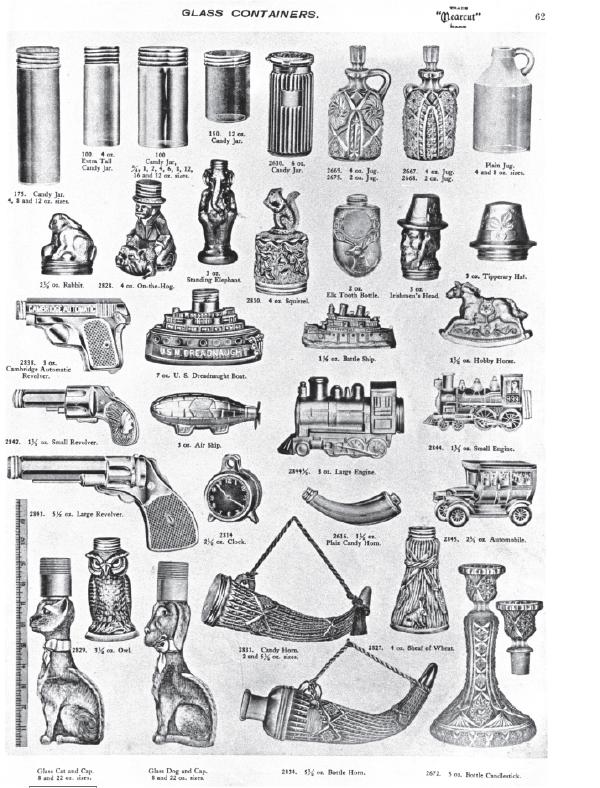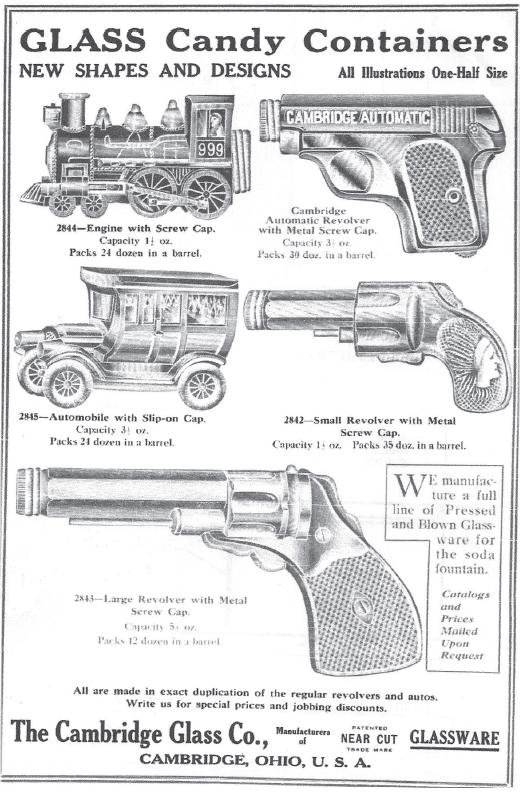More on Candy Containers
by Frank Wollenhaupt
Issue No. 463 - November/December 2012
This past month I received an envelope in the mail from Jim Olean, Membership chairman of the Candy Container Collectors of America. I was kind of surprised to be getting something from the Candy Container Collectors but after opening it, I was happy. They sent me two copies of their news letter, "The Candy Gram" it was the winter 2011 and spring 2012. They did a two part story about Cambridge Candy containers. It was a great story and included several very good photos.
After reading the story several times, I contacted Jim and talked for a while about candy containers in general and Cambridge containers specifically. I found out the reason why I got the copies. He had included my candy container "Titanic" story (issue #437 – April 2010) and wanted me to have a copy. He also had found a nice advertisement that I have permission to use.
One thing that came out of the conversation with Jim was how they (candy container collectors) are careful to make sure that what they collect are really "CANDY" containers. They are looking for ads and trying to document the use of the items that they collect.
Before we go further, I should clear up what a candy container actually happens to be? It is normally a glass toy that is filled with small seed candy that when empty, a child could play with. Fourteen different companies produced over 100 different types of containers. Several companies produced the same basic item but with changes. Can you believe that one time we let small children play with glass toys?
Case in point ... look at the catalog page (at the end of this article). This came from an early Near Cut catalog (1910/15); an exact date cannot be ascertained because the catalog isn't dated. I look at the page and see 23 candy containers. Some of "Non Cambridge" candy container collectors find exceptions to those numbers. Yes, you can find all the Cambridge Glass containers listed in the books but some of them have the statement (Believed to be but not confirmed.) What they are really saying is they can't document for sure that it was sold as a candy container.
In the Cambridge advertisement (at the end of this article), we can say for sure that the #2844 Small Engine, #2845 Automobile, #2842 Small Revolver with Indian Head, #2843 Large Revolver and the Cambridge Automatic were sold as candy containers. They also believe without a doubt the Rabbit, Standing Elephant, #2830 Squirrel, Irishmen's Head, Tipperary Hat, Battle Ship, Hobby Horse, Air Ship, #2844 ½ Large Engine, #2814 Clock, #2616 Plain Candy Horn, #2833 Candy Horn are also "candy containers".
They believe that the #2827 Sheaf of Wheat was also sold as a candy container but in an early article (issue #230 – June 1992), Mark Nye said the mold was destroyed as a "shaker". I have never seen this listed in any catalog as a "shaker" and can only believe that when the molds were destroyed, shaker was a term used to describe it because they didn't realize that it was a "candy container".
The items that they are up in the air about are the #2828 On-The- Hog, Elk Tooth Bottle, U.S. Dreadnaught Boat and the #2829 Owl. They have never seen the On-The-Hog or Owl and doubt if they were ever made.
I would be interested in hearing from anyone that collects Cambridge candy containers or from anyone that has seen the On-The-Hog or the Owl container.


